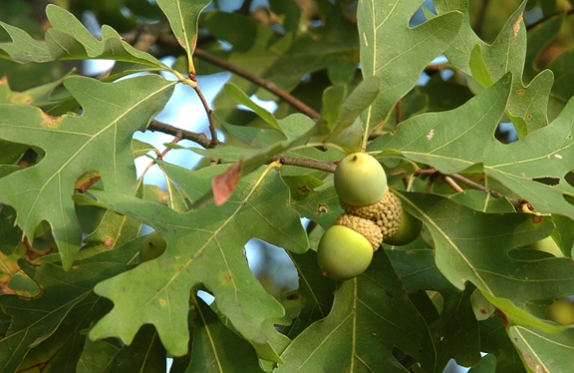The key to improving acorn production in oaks begins with identifying the best acorn-producing trees where you hunt, and I shared an acorn survey technique for doing so in the first part of this two-part series. Once you have identified the best acorn producers in the stand, it’s time to conduct a timber harvest to improve acorn production (whether you cut the trees yourself or allow a logger to do the work). The efforts you have taken with your acorn survey, combined with the following guidelines, will encourage more consistent, abundant acorn crops from your oak stands — and that means better deer habitat, nutrition and hunting opportunities!
Release Marked Trees
Now that you have identified your best producers, the first step should be to provide those trees with growing room. Remove (or have a professional forester or logger remove) any poor producers whose crowns are touching the crowns of your marked trees. Ideally, you want competing trees removed from at least three sides of your best producers. If done correctly, your stands will need this treatment only once every 12 to 15 years; as soon as the crowns of neighboring trees start touching again, it will be time for another harvest.
Maintain Species Diversity
Work to maintain a diversity of oak species on your property. A good guideline is to manage your oak stands to be composed of one tree in the white oak family for every three in the red oak family (1:3). Red oaks are more consistent producers than white oaks, and having both groups of species in the same stand will buffer against a total crop failure if one group doesn’t produce acorns. Also, retain other mast-producing species like American beech. These trees provide your deer with another food source and buffer against poor acorn crop years.
Manage for Age Class
To maximize acorn production, at least half of your oak stands should be composed of trees greater than 50 years old. Work to have this age-class distributed evenly across your forested acreage. Locate younger stands directly next to 50-year-old-plus stands to provide browse and cover opportunities for your deer.
Manage for Size Class
Allow your best acorn producers to grow larger than 20 inches in diameter, as most oak species begin producing their largest crops at this size. Periodically thinning around these trees every 12 to 15 years will encourage good acorn production for many years.Don’t let anyone talk you into a timber harvest where all trees over a certain diameter will be harvested. Such “diameter-limit” cuts will reduce acorn production and can significantly reduce the quality and health of your oak stands. Conduct your acorn surveys prior to each timber sale to determine when a large diameter tree is no longer producing large crops consistently.
Skip the Fertilizer
Fertilize your food plots, not your forest. Don’t waste your time and money trying to fertilize oaks to increase acorn production. Although there is some competition between trees for water and nutrients, sunlight is by far the most important resource your trees need for growing large acorn crops. Acorn production is so variable from year to year, it’s difficult to prove that fertilizer is responsible for any change you observe in your acorn crop. In fact, a long-term study now underway is already revealing that fertilizer has no apparent benefit for acorn production. The same study is showing that thinning your oaks is a much more effective way to provide your trees with the resources they need to produce acorns. Take what time you had set aside for fertilizing oaks and use it to conduct the acorn survey.
Consult a Forestry Professional
Much if not all the work involved in removing poor-producing oaks to give more resources to the strong producers can be done by you and your chainsaw. However, there’s a good chance you may be able to harvest a profit from the oaks you will be removing, especially with large-scale projects. That’s why the first step in any timber-harvesting operation is to consult a forestry professional to help you prepare and oversee your timber harvest. If managed correctly, your oak stands should pay for themselves and help offset the cost of other management projects on your property.
Manage by Basal Area
Foresters use basal area as a guide to determine the correct distribution of trees needed to meet your management objectives (basal area is the cross-sectional area of a tree measured at 4½ feet above the ground). The best acorn production will be achieved in stands where basal area is between 60 and 100 square feet per acre and oaks average greater than 20 inches in diameter measured at chest height. I suggest your forester use the higher basal area because it allows you to retain a few more trees per acre; this provides insurance for those times when a tree you’ve identified as a “good producer” turns out to be not so good after all. The concept of basal area isn’t difficult, but it is best taught in the field; ask your forester to show you how to measure the basal area of your forest stands.
If you follow the survey and management guidelines presented in this article you will be rewarded with improved growth and acorn production from your oaks. Additionally, the timber sale will increase sunlight into your forest and stimulate the growth of stump sprouts and oak seedlings; those not eaten by deer can be nurtured as your future oak stand. Money you generate from the timber sale can be used to pay for other habitat improvement projects, or to have your next acorn-fed buck mounted!
The information for this article was originally published in QDMA’s Quality Whitetails magazine, authored by Matthew Tarr – University of New Hampshire Cooperative Extension Wildlife Specialist – and is shared here as a sample of the information QDMA members receive. To start receiving Quality Whitetails, join QDMA today.
